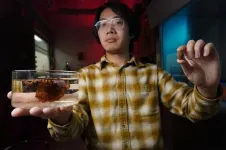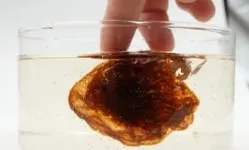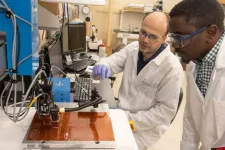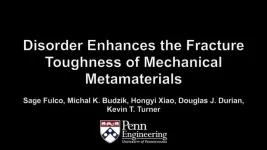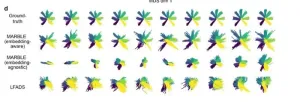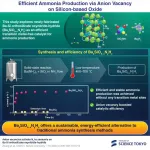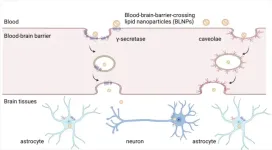(Press-News.org) A nut used in herbal tea has become a hydrogel perfect for a variety of biomedical uses in new research from the University of Chicago Pritzker School of Engineering (UChicago PME) and UChicago Chemistry Department.
A paper published today in Matter created a malva nut hydrogel for medical uses ranging from wound care to ECG readings. The research doesn’t rely on the rumored health benefits of the nuts – in China, they’re known as the sore throat remedy Pangdahai (PDH) – but for their ability to swell in water.
“You never saw the fruit from a tree expand in that kind of volume,” said first author Changxu Sun, a UChicago PME PhD student.
Where others saw gooey tea residue, Sun saw possibility.
“It is a remarkable discovery from a remarkable student,” said Sun’s principal investigator, University of Chicago Chemistry Prof. Bozhi Tian. “Changxu looked at herbal tea and saw a world of sustainable biomedical applications ready to be built.”
From tea...
In traditional Chinese medicine, malva nuts are known as Pangdahai, often used in tea as a sore throat remedy, similar to adding ginger or lemon. A sniffling person pops the small, dried nut in hot water and watches the magic unfold.
“Originally, it’s an oval shape one centimeter in width. Once you soak it in the water, it will expand about eight times in volume and 20 times by weight, turning into a gelatinous mass, like a jelly,” Sun said. “After you drink the beverage, you’re left the jelly as a waste. People usually throw that out.”
For comparison, rice swells by about three times by weight when cooked. Chia seeds swell to 10 times their weight when added to water; the snow fungus used in many Asian soups has a similar rate.
But the malva nuts’ 20-fold increase leaves them all behind. Sun and Tian saw potential in the gelatinous food waste thrown out with yesterday’s tea.
“We said, ‘Okay, that's a natural hydrogel,’” Sun said.
... to hydrogel
Hydrogels are gooey water-based substances noted for their many applications in health care. As soft and water-loving as human tissue itself, hydrogels are used in wound care, fighting infection and spurring healing beyond what a bandage can do. They’re used in drug delivery systems, implantable bioelectronics like pacemakers, tissue repair, ECG and EKG readings, and other uses.
Turning nuts into medical devices takes more work than just popping them in tea.
First, the nuts are crushed in a blender and then run through a centrifuge to extract as much of the soft, expanding polysaccharide hydrocolloid as possible while getting rid of the hard structural lignins that give nuts their shells.
They then freeze-dry the hydrocolloid solution, removing all the water to create a dry scaffolding of pure malva nut polysaccharide. Picture a dried-out kitchen sponge popping back into shape under the kitchen tap.
“If we hydrate those scaffolds again, that becomes a gel,” Sun said.
The team began testing their malva nut hydrogel in a variety of medical uses, from wound care to biomonitoring.
“We found it demonstrated superior performance and qualities compared to commercial ECG patches. And then we also applied to the tissue surface in vivo, demonstrating great recording of biosignals,” Sun said. “We wanted to show people should shift their attention into the unexplored properties and unexplored resources of natural plants.”
Sun hopes the new, naturally derived hydrogel will provide a new source of powerful but less-expensive medical resources across the globe, but particularly in the Southeast Asian nations where the malva tree grows.
“They’re low-income countries. Their healthcare systems are always limited by this lack of resources,” Sun said. “Here we have a local, native material that can be used to create valuable healthcare solutions while providing these impoverished areas some economic stability.”
That doesn’t sound nuts at all.
Citation: “Sustainable Conversion of Husk into Viscoelastic Hydrogels for Value-Added Biomedical Applications,” Sun et al, Matter, February 17, 2025. DOI: 10.1016/j.matt.2025.102002.
END
This research is absolutely nuts – for better health care
A University of Chicago Pritzker Molecular Engineering PhD student has created a new material from tree nuts with a broad number of medical applications that benefit patients
2025-02-17
ELSE PRESS RELEASES FROM THIS DATE:
Genetic study links defects in sugar digestion to irritable bowel syndrome
2025-02-17
Sucrase-isomaltase (SI) is an intestinal enzyme critical for the digestion of dietary carbohydrates, particularly sucrose and starch. Previous studies from the Gastrointestinal Genetics team at CIC bioGUNE - BRTA and LUM University suggested a genetic link between SI defects and IBS, whereby certain DNA changes cause reduced enzymatic activity and inefficient digestion of carbohydrates, thus inducing symptoms like bloating, diarrhoea, and abdominal pain. As the name gives away, however, SI is a special case in that it encompasses two enzymes with different carbohydrate-digesting ...
Binghamton University, State University of New York retains top research ranking among elite universities
2025-02-17
BINGHAMTON, N.Y. -- Binghamton University maintains its status as an R1 institution for its prolific research activity, according to a new list from the Carnegie Classification of Institutions of Higher Education.
Every three years, the Carnegie Classification looks at schools’ research expenditures and graduate programs to evaluate which campuses can be considered an R1 institution for “very high spending and doctorate production.”
Schools with this designation must spend at least $50 million on research and development and award at least 70 research doctorates. Binghamton wrapped ...
Breaking the pattern: How disorder toughens materials
2025-02-17
Cut open a bone and you’ll see a subtly disordered structure. Tiny beams, called trabeculae, connect to one another in irregular patterns, distributing stress and lending bones an impressive toughness. What if human-made materials could exhibit similar properties?
In a new paper in Proceedings of the National Academy of Sciences Nexus, researchers at Penn Engineering, Penn Arts & Sciences and Aarhus University found that adding just the right amount of disorder to the structure of certain materials can make them more than twice as resistant to cracking.
The finding opens the door to more widespread use of so-called “mechanical metamaterials,” ...
A geometric deep learning method for decoding brain dynamics
2025-02-17
In the parable of the blind men and the elephant, several blind men each describe a different part of an elephant they are touching – a sharp tusk, a flexible trunk, or a broad leg – and disagree about the animal’s true nature. The story illustrates the problem of understanding an unseen, or latent object based on incomplete individual perceptions. Likewise, when researchers study brain dynamics based on recordings of a limited number of neurons, they must infer the latent patterns of brain dynamics that generate these recordings.
“Suppose you and I both engage in a mental task, ...
Novel catalyst development for sustainable ammonia synthesis
2025-02-17
As the world moves toward sustainability, the demand for efficient alternatives across industries continues to grow. Ammonia, a key chemical used in fertilizers, explosives, and various other products, is primarily synthesized through the energy-intensive Haber-Bosch process. This process requires extremely high temperatures and pressures, contributing to global carbon dioxide emissions. Conventional catalysts, such as iron and ruthenium, rely on these harsh conditions to drive the reaction. However, a recent study by researchers from Institute of Science Tokyo, the National Institute for Materials Science, and Tohoku University, Japan, led by Professor Masaaki Kitano, explores ...
Researchers identify DNA changes, biological pathways associated with inherited cancer risk
2025-02-17
Thousands of single changes in the nucleotides that make up the human genome have been associated with an increased risk of developing cancer. But until now, it’s not been clear which are directly responsible for the uncontrolled cellular growth that is the hallmark of the disease and which are simply coincidences or minor players.
Stanford researchers have conducted the first large-scale screen of these inherited changes, called single nucleotide variants, and homed in on fewer than 400 that are essential to initiate and drive cancer growth. These variants control several common biological ...
New lipid nanoparticle platform delivers mRNA to the brain through the blood-brain barrier
2025-02-17
New York, NY [February 17, 2025]—Scientists at the Icahn School of Medicine at Mount Sinai have developed a lipid nanoparticle system capable of delivering messenger RNA (mRNA) to the brain via intravenous injection, a challenge that has long been limited by the protective nature of the blood-brain barrier.
The findings, in mouse models and isolated human brain tissue, were published in the February 17 online issue of Nature Materials [10.1038/s41563-024-02114-5]. They demonstrate the potential of this technology to pave the way for ...
Wildfires in the Andes cause severe soil degradation and hinder ecosystem recovery
2025-02-17
In September 2018, a wildfire burned nearly two thousand hectares of shrubland on the Pichu Pichu volcano, an ecologically significant area in the Peruvian Andes. Unlike Mediterranean ecosystems, where vegetation has evolved strategies to withstand fire, the volcanic soils of Arequipa—one of the driest regions in the world—are not adapted to wildfire disturbances. A Miguel Hernández University of Elche (UMH) research team collected and analyzed soil samples from the burned area at 3,700 meters above sea level to understand how these fragile ecosystems ...
Men and boys matter: Psychology professor reveals hidden issues we need to talk about
2025-02-17
These include those linked to body image, fatherhood and sexual relationships. His latest book - Current Issues Facing Men and Boys – also argues that men struggle to negotiate harmful notions of masculinity and are not included in conversations around gender.
Current Issues Facing Men and Boys urges the public, policymakers, practitioners and other key stakeholders to explore and support policies and practices that promote male wellbeing. This book comes as the UK government announces plans for the country's first men's health strategy, aiming ...
1 in 6 parents support teens getting non-surgical cosmetic procedures with parental consent
2025-02-17
For teens who may be self-conscious about issues such as acne scarring or discolored teeth, non-surgical cosmetic procedures are an increasingly popular way to address their concerns.
And some parents are supportive of this decision, a national poll suggests, with a sixth saying teenagers should be allowed to receive these types of aesthetic treatments for any reason as long as they have parental approval.
But half of parents only support teens getting non-surgical cosmetic procedures if there’s a valid reason – and their beliefs about which reasons count as valid differ – according to ...
LAST 30 PRESS RELEASES:
Post-stroke injection protects the brain in preclinical study
Cardiovascular risk score predicts multiple eye diseases
Health: estimated one in ten British adults used or interested in GLP-1 medications for weight loss
Exercise to treat depression yields similar results to therapy
Whooping cough vaccination for pregnant women strengthens babies’ immune system
Dramatic decline in new cases of orphanhood in Uganda driven by HIV treatment and prevention programs
Stopping weight loss drugs linked to weight regain and reversal of heart health markers
Higher intake of food preservatives linked to increased cancer risk
Mass General Brigham–developed cholera vaccine completes phase 1 trial
First experimental validation of a “150-year-old chemical common sense” direct visualization of the molecular structural changes in the ultrafast anthracene [4+4] photocycloaddition reaction
Lack of support for people on weight loss drugs leaves them vulnerable to nutritional deficiencies, say experts
Dogs’ dinners can have greater climate impact than owners’
Are you ready to swap salmon for sprats and sardines?
1.6 million UK adults used weight loss drugs in past year
American College of Cardiology comments on new dietary guidelines for Americans
American Society of Gene & Cell Therapy and Orphan Therapeutics Accelerator partner to advance and commercialize promising rare disease treatments
One in 14 patients having day case surgery have new or worse chronic pain 3 months after their operation
New study highlights link between eviction rates and gun violence
Heatwaves heat up soil but not toxin levels in rice, study finds
Digital modeling reveals where construction carbon emissions really come from
Turning farm waste into water filters
New study shows how the spleen helps the immune system accept a transplant
New Mayo Clinic study advances personalized prostate cancer education with an EHR-integrated AI agent
Researchers identify novel therapeutic target to improve recovery after nerve injury
Microbes in breast milk help populate infant gut microbiomes
Reprogramming immunity to rewrite the story of Type 1 diabetes
New tool narrows the search for ideal material structures
Artificial saliva containing sugarcane protein helps protect the teeth of patients with head and neck cancer
Understanding the role of linear ubiquitination in T-tubule biogenesis
Researchers identify urban atmosphere as primary reservoir of microplastics
[Press-News.org] This research is absolutely nuts – for better health careA University of Chicago Pritzker Molecular Engineering PhD student has created a new material from tree nuts with a broad number of medical applications that benefit patients
